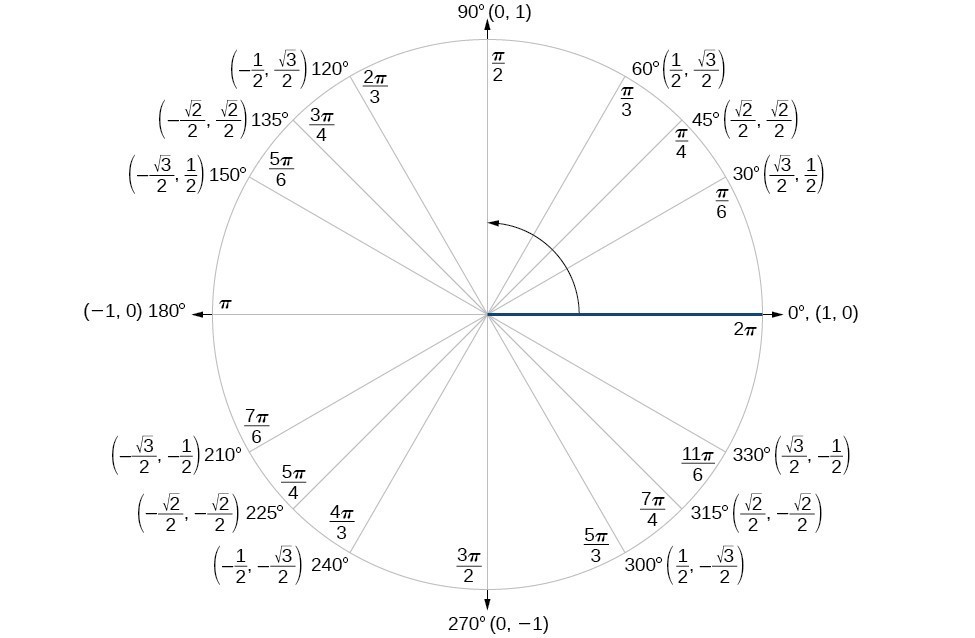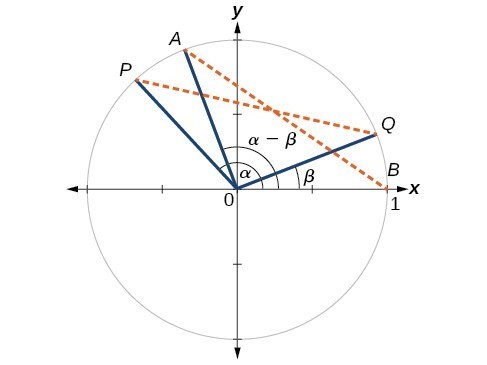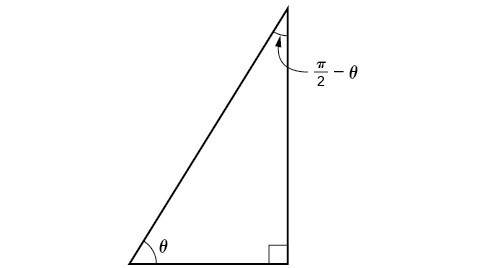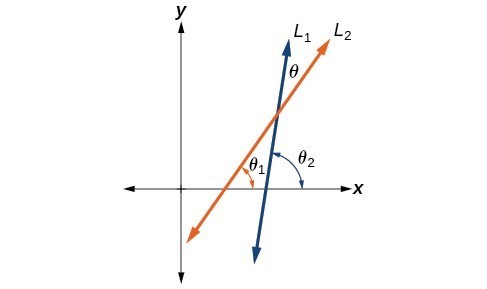Sum and Difference Identities
Use sum and difference formulas for cosine
Finding the exact value of the sine, cosine, or tangent of an angle is often easier if we can rewrite the given angle in terms of two angles that have known trigonometric values. We can use the special angles, which we can review in the unit circle shown in Figure 2. Figure 2. The Unit Circle
Figure 2. The Unit Circle| Sum formula for cosine | |
| Difference formula for cosine |

Figure 3. We can find the distance from to using the distance formula.
Then we apply the Pythagorean identity and simplify.
Similarly, using the distance formula we can find the distance from to .
Applying the Pythagorean identity and simplifying we get:
Because the two distances are the same, we set them equal to each other and simplify.
Finally we subtract from both sides and divide both sides by .
Thus, we have the difference formula for cosine. We can use similar methods to derive the cosine of the sum of two angles.
A General Note: Sum and Difference Formulas for Cosine
These formulas can be used to calculate the cosine of sums and differences of angles.How To: Given two angles, find the cosine of the difference between the angles.
- Write the difference formula for cosine.
- Substitute the values of the given angles into the formula.
- Simplify.
Example 1: Finding the Exact Value Using the Formula for the Cosine of the Difference of Two Angles
Using the formula for the cosine of the difference of two angles, find the exact value of .Solution
Use the formula for the cosine of the difference of two angles. We haveExample 2: Finding the Exact Value Using the Formula for the Sum of Two Angles for Cosine
Find the exact value of .Solution
As , we can evaluate as . Thus,Use sum and difference formulas for sine
The sum and difference formulas for sine can be derived in the same manner as those for cosine, and they resemble the cosine formulas.A General Note: Sum and Difference Formulas for Sine
These formulas can be used to calculate the sines of sums and differences of angles.How To: Given two angles, find the sine of the difference between the angles.
- Write the difference formula for sine.
- Substitute the given angles into the formula.
- Simplify.
Example 3: Using Sum and Difference Identities to Evaluate the Difference of Angles
Use the sum and difference identities to evaluate the difference of the angles and show that part a equals part b.Solution
- Let’s begin by writing the formula and substitute the given angles.
Next, we need to find the values of the trigonometric expressions.Now we can substitute these values into the equation and simplify.
- Again, we write the formula and substitute the given angles.
Next, we find the values of the trigonometric expressions.Now we can substitute these values into the equation and simplify.
Example 4: Finding the Exact Value of an Expression Involving an Inverse Trigonometric Function
Find the exact value of .Solution
The pattern displayed in this problem is . Let and . Then we can write
We will use the Pythagorean identities to find and .
Using the sum formula for sine,
Use sum and difference formulas for tangent
Finding exact values for the tangent of the sum or difference of two angles is a little more complicated, but again, it is a matter of recognizing the pattern. Finding the sum of two angles formula for tangent involves taking quotient of the sum formulas for sine and cosine and simplifying. Recall, . Let’s derive the sum formula for tangent.
We can derive the difference formula for tangent in a similar way.
A General Note: Sum and Difference Formulas for Tangent
The sum and difference formulas for tangent are:How To: Given two angles, find the tangent of the sum of the angles.
- Write the sum formula for tangent.
- Substitute the given angles into the formula.
- Simplify.
Example 5: Finding the Exact Value of an Expression Involving Tangent
Find the exact value of .Solution
Let’s first write the sum formula for tangent and substitute the given angles into the formula.
Next, we determine the individual tangents within the formula:
So we have
Example 6: Finding Multiple Sums and Differences of Angles
Given , findSolution
We can use the sum and difference formulas to identify the sum or difference of angles when the ratio of sine, cosine, or tangent is provided for each of the individual angles. To do so, we construct what is called a reference triangle to help find each component of the sum and difference formulas.- To find , we begin with and . The side opposite has length 3, the hypotenuse has length 5, and is in the first quadrant. Using the Pythagorean Theorem, we can find the length of side
Since and , the side adjacent to is , the hypotenuse is 13, and is in the third quadrant. Again, using the Pythagorean Theorem, we have
 Figure 4Since is in the third quadrant, .The next step is finding the cosine of and the sine of . The cosine of is the adjacent side over the hypotenuse. We can find it from the triangle in Figure 5: . We can also find the sine of from the triangle in Figure 5, as opposite side over the hypotenuse: . Now we are ready to evaluate .
Figure 4Since is in the third quadrant, .The next step is finding the cosine of and the sine of . The cosine of is the adjacent side over the hypotenuse. We can find it from the triangle in Figure 5: . We can also find the sine of from the triangle in Figure 5, as opposite side over the hypotenuse: . Now we are ready to evaluate . Figure 5
Figure 5 - We can find in a similar manner. We substitute the values according to the formula.
- For , if and , then
If and , thenThen,
- To find , we have the values we need. We can substitute them in and evaluate.
Analysis of the Solution
A common mistake when addressing problems such as this one is that we may be tempted to think that and are angles in the same triangle, which of course, they are not. Also note thatUse sum and difference formulas for cofunctions
Now that we can find the sine, cosine, and tangent functions for the sums and differences of angles, we can use them to do the same for their cofunctions. You may recall that if the sum of two positive angles is , those two angles are complements, and the sum of the two acute angles in a right triangle is , so they are also complements. In Figure 6, notice that if one of the acute angles is labeled as , then the other acute angle must be labeled . Figure 6. From these relationships, the cofunction identities are formed.
Figure 6. From these relationships, the cofunction identities are formed.A General Note: Cofunction Identities
The cofunction identities are summarized in the table below.,
we can write
Example 7: Finding a Cofunction with the Same Value as the Given Expression
Write in terms of its cofunction.Solution
The cofunction of . Thus,Use sum and difference formulas to verify identities
Verifying an identity means demonstrating that the equation holds for all values of the variable. It helps to be very familiar with the identities or to have a list of them accessible while working the problems.How To: Given an identity, verify using sum and difference formulas.
- Begin with the expression on the side of the equal sign that appears most complex. Rewrite that expression until it matches the other side of the equal sign. Occasionally, we might have to alter both sides, but working on only one side is the most efficient.
- Look for opportunities to use the sum and difference formulas.
- Rewrite sums or differences of quotients as single quotients.
- If the process becomes cumbersome, rewrite the expression in terms of sines and cosines.
Example 8: Verifying an Identity Involving Sine
Verify the identity .Solution
We see that the left side of the equation includes the sines of the sum and the difference of angles.
We can rewrite each using the sum and difference formulas.
We see that the identity is verified.
Example 9: Verifying an Identity Involving Tangent
Verify the following identity.Solution
We can begin by rewriting the numerator on the left side of the equation.
We see that the identity is verified. In many cases, verifying tangent identities can successfully be accomplished by writing the tangent in terms of sine and cosine.
Example 10: Using Sum and Difference Formulas to Solve an Application Problem
Let and denote two non-vertical intersecting lines, and let denote the acute angle between and . Show that
where and are the slopes of and respectively. (Hint: Use the fact that and . )
 Figure 7
Figure 7Solution
Using the difference formula for tangent, this problem does not seem as daunting as it might.Example 11: Investigating a Guy-wire Problem
 Figure 8
Figure 8Solution
Let’s first summarize the information we can gather from the diagram. As only the sides adjacent to the right angle are known, we can use the tangent function. Notice that , and . We can then use difference formula for tangent.
Now, substituting the values we know into the formula, we have
Use the distributive property, and then simplify the functions.
Now we can calculate the angle in degrees.
Analysis of the Solution
Occasionally, when an application appears that includes a right triangle, we may think that solving is a matter of applying the Pythagorean Theorem. That may be partially true, but it depends on what the problem is asking and what information is given.Key Equations
| Sum Formula for Cosine | |
| Difference Formula for Cosine | |
| Sum Formula for Sine | |
| Difference Formula for Sine | |
| Sum Formula for Tangent | |
| Difference Formula for Tangent | |
| Cofunction identities |
Key Concepts
- The sum formula for cosines states that the cosine of the sum of two angles equals the product of the cosines of the angles minus the product of the sines of the angles. The difference formula for cosines states that the cosine of the difference of two angles equals the product of the cosines of the angles plus the product of the sines of the angles.
- The sum and difference formulas can be used to find the exact values of the sine, cosine, or tangent of an angle.
- The sum formula for sines states that the sine of the sum of two angles equals the product of the sine of the first angle and cosine of the second angle plus the product of the cosine of the first angle and the sine of the second angle. The difference formula for sines states that the sine of the difference of two angles equals the product of the sine of the first angle and cosine of the second angle minus the product of the cosine of the first angle and the sine of the second angle.
- The sum and difference formulas for sine and cosine can also be used for inverse trigonometric functions.
- The sum formula for tangent states that the tangent of the sum of two angles equals the sum of the tangents of the angles divided by 1 minus the product of the tangents of the angles. The difference formula for tangent states that the tangent of the difference of two angles equals the difference of the tangents of the angles divided by 1 plus the product of the tangents of the angles.
- The Pythagorean Theorem along with the sum and difference formulas can be used to find multiple sums and differences of angles.
- The cofunction identities apply to complementary angles and pairs of reciprocal functions.
- Sum and difference formulas are useful in verifying identities.
- Application problems are often easier to solve by using sum and difference formulas.
